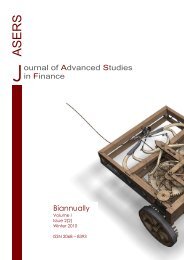Can Shift to a Funded Pension System Affect - ASERS
Can Shift to a Funded Pension System Affect - ASERS
Can Shift to a Funded Pension System Affect - ASERS
Create successful ePaper yourself
Turn your PDF publications into a flip-book with our unique Google optimized e-Paper software.
Theoretical and Practical Research in Economic Fields<br />
CAN SHIFT TO A FUNDED PENSION SYSTEM AFFECT NATIONAL<br />
SAVING? THE CASE OF ICELAND<br />
Mariangela BONASIA<br />
University of Naples, Parthenope, Italy<br />
mariangela.bonasia@uniparthenope.it<br />
Oreste NAPOLITANO<br />
University of Naples, Parthenope, Italy<br />
napolitano@uniparthenope.it<br />
Abstract<br />
Across industrialised and developing countries public pension systems have been heavily reformed during the last<br />
two decades. The major concern relates the financial sustainability of pay-as-you-go pension schemes. The proposals <strong>to</strong><br />
privatize social security lead <strong>to</strong> the creation of a multipillar system. This study assesses the validity of the effect of pension<br />
reforms on domestic savings in two steps: first, <strong>to</strong> test for the existence of a long-run relationship, we use an ARDL model;<br />
second, we employ the Kalman filter algorithm, in order <strong>to</strong> recover the parameter dynamics overtime. We analyse the case of<br />
Iceland because its pension system is characterized by a large manda<strong>to</strong>ry private pillar. The empirical evidence supports the<br />
widely held view that growing manda<strong>to</strong>ry pension funds financial assets has significantly positive impact on national saving.<br />
Moreover, we show that the pattern of the pension funds’ coefficients seems <strong>to</strong> capture well the economic dynamic of the<br />
period. The coefficients of the funded pillars illustrate a shift upward soon after the launch of the reforms in 1998. Later on,<br />
these coefficients show a negative trend till the middle of 2004 and they increase sharply until the beginning of 2006.<br />
Afterwards, following the Icelandic and international financial crisis, they strongly declines.<br />
Keywords: national saving, pension funds, multipillar system, ARDL model, Kalman filter<br />
JEL Classification: E21, G23, H55<br />
1. Introduction<br />
Within the past two decades many countries around the globe have implemented intense pension reforms,<br />
which have often involved an increased use of funded pension programmes managed by the private sec<strong>to</strong>r.<br />
Most of the world‟s countries are characterized by public pension provision financed by tax contributions<br />
on a pay-as-you-go basis, even if there could be important differences in size and degree of targeting (universal<br />
and/or means-tested). Currently, the western countries are facing lower growth rates while declining fertility rates<br />
and lower mortality rates are leading <strong>to</strong> an increase in the dependency ratio. As a consequence, the most<br />
unfunded systems are faced with financial sustainability problems. Many countries have enacted reforms which<br />
cut benefits and increase contributions and consequently most reformed pension systems are increasingly based<br />
on the rejection of the dominance of the public pension pillar. Hence, the aim is <strong>to</strong> move <strong>to</strong> a multipillar 5 system<br />
with a greater role given <strong>to</strong> the private sec<strong>to</strong>r, so that it can provide a minimum floor income for the elderly.<br />
There are several reasons <strong>to</strong> increase funding within public or private pension systems. Among others 6 ,<br />
the one that is strictly related <strong>to</strong> the object of this paper is that such a policy could produce an equivalent increase<br />
in national saving, reducing the burden placed on the future workers who must support the retired elderly. Since<br />
Feldstein‟s seminal work (1974), this <strong>to</strong>pic has been on the research agenda for over two decades. A heated<br />
debate has developed over the merits of a social security reform based on the building of a multipillar system<br />
and, in particular, over its impact on saving. This paper intends <strong>to</strong> investigate whether this explanation for<br />
advanced funding is valid. In doing so we try <strong>to</strong> estimate the effect on national saving of an increase in manda<strong>to</strong>ry<br />
private pension funding in Iceland, a country that is increasingly meeting the criteria of the pro<strong>to</strong>type three pillar<br />
system as suggested by the World Bank (1994). Its social security system could be a typical example of a great<br />
5 Each pension pillar provides the three functions in different ways. The first pillar, public pay-as-you-go, usually<br />
defined-benefit and redistributive, should provide social safety net support <strong>to</strong> everyone. The second one is a privately<br />
managed funded pillar that handles peoples‟ manda<strong>to</strong>ry retirement savings; unlike the public pillar – which is redistributive,<br />
centrally controlled, and tax-financed - the second manda<strong>to</strong>ry pillar should highlight savings. Finally, the third pillar<br />
encourages discretionary retirement savings and capital development.<br />
6 Another justification for proposals <strong>to</strong> shift from pay go <strong>to</strong> private pension schemes is that such a policy will remedy<br />
<strong>to</strong> labour market dis<strong>to</strong>rtions (Arrau, and Schmidt-Hebbel 1995; Feldstein 1996; Feldstein, and Samwick 1997; Kotlikoff<br />
1996a, and 1996b). However, the aim of this paper is not <strong>to</strong> analyse the relationship between funded pension schemes and<br />
labour market.<br />
12











